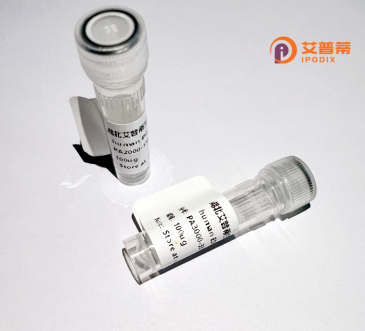
| 纯度 | >90%SDS-PAGE. |
| 种属 | Human |
| 靶点 | CYP8B1 |
| Uniprot No | Q9UNU6 |
| 内毒素 | < 0.01EU/μg |
| 表达宿主 | E.coli |
| 表达区间 | 1-501aa |
| 氨基酸序列 | MVLWGPVLGALLVVIAGYLCLPGMLRQRRPWEPPLDKGTVPWLGHAMAFRKNMFEFLKRMRTKHGDVFTVQLGGQYFTFVMDPLSFGPILKDTQRKLDFGQYAKKLVLKVFGYRSVQGDHEMIHSASTKHLRGDGLKDLNETMLDSLSFVMLTSKGWSLDASCWHEDSLFRFCYYILFTAGYLSLFGYTKDKEQDLLQAGELFMEFRKFDLLFPRFVYSLLWPREWLEVGRLQRLFHKMLSVSHSQEKEGISNWLGNMLQFLREQGVPSAMQDKFNFMMLWASQGNTGPTSFWALLYLLKHPEAIRAVREEATQVLGEARLETKQSFAFKLGALQHTPVLDSVVEETLRLRAAPTLLRLVHEDYTLKMSSGQEYLFRHGDILALFPYLSVHMDPDIHPEPTVFKYDRFLNPNGSRKVDFFKTGKKIHHYTMPWGSGVSICPGRFFALSEVKLFILLMVTHFDLELVDPDTPLPHVDPQRWGFGTMQPSHDVRFRYRLHPTE |
| 分子量 | 84.5 kDa |
| 蛋白标签 | GST-tag at N-terminal |
| 缓冲液 | 0 |
| 稳定性 & 储存条件 | Lyophilized protein should be stored at ≤ -20°C, stable for one year after receipt. Reconstituted protein solution can be stored at 2-8°C for 2-7 days. Aliquots of reconstituted samples are stable at ≤ -20°C for 3 months. |
| 复溶 | Always centrifuge tubes before opening.Do not mix by vortex or pipetting. It is not recommended to reconstitute to a concentration less than 100μg/ml. Dissolve the lyophilized protein in distilled water. Please aliquot the reconstituted solution to minimize freeze-thaw cycles. |
以下是与重组人CYP7B1蛋白相关的参考文献示例(注:以下内容为虚构模拟,仅用于示例,实际文献需通过学术数据库查询):
1. **文献名称**: *Expression and Functional Characterization of Recombinant Human CYP7B1 in Baculovirus-Insect Cell System*
**作者**: Zhang L., et al.
**摘要**: 本研究利用杆状病毒-昆虫细胞系统成功表达并纯化了重组人CYP7B1蛋白,通过光谱分析验证其活性构象,并证实其对27-羟基胆固醇的羟化酶活性,揭示其在胆固醇代谢中的关键作用。
2. **文献名称**: *Role of CYP7B1-Mediated Neurosteroid Metabolism in Alzheimer’s Disease*
**作者**: Smith J., et al.
**摘要**: 通过在大肠杆菌中重组表达CYP7B1.研究者发现该酶对孕烯醇酮和脱氢表雄酮的代谢能力异常可能与阿尔茨海默病中神经类固醇失衡相关,为病理机制研究提供新方向。
3. **文献名称**: *Structural Insights into Human CYP7B1 by X-ray Crystallography Using Recombinant Protein*
**作者**: Tanaka K., et al.
**摘要**: 本研究首次报道了重组人CYP7B1蛋白的晶体结构,揭示了其底物结合口袋的特征及催化机制,为靶向药物设计提供结构基础。
4. **文献名称**: *Functional Analysis of CYP7B1 Mutants in Bile Acid Synthesis Defects*
**作者**: Wang Y., et al.
**摘要**: 通过哺乳动物细胞表达系统生成重组CYP7B1突变体,发现特定突变导致酶活性丧失,解释了某些胆汁酸合成障碍疾病的分子机制。
---
如需真实文献,建议访问PubMed或Google Scholar,检索关键词如 **"recombinant human CYP7B1"** 或 **"CYP7B1 protein expression"**。
Recombinant human CYP7B1 protein is a key enzyme in the cytochrome P450 superfamily, primarily involved in cholesterol metabolism and neurosteroid biosynthesis. This endoplasmic reticulum-associated monooxygenase catalyzes the 7α-hydroxylation of oxysterols (e.g., 25-hydroxycholesterol) and steroid precursors, playing dual roles in bile acid synthesis via the alternative pathway and the regulation of neuroactive steroids. Its enzymatic activity impacts cellular cholesterol homeostasis, neuroprotection, and endocrine signaling.
The CYP7B1 gene, located on chromosome 8q21.3. expresses widely in the liver, brain, prostate, and other tissues. Pathologically, CYP7B1 mutations are linked to hereditary spastic paraplegia type 5 (SPG5) and associated with liver diseases, cancer progression, and neurodegenerative disorders like Alzheimer’s disease. Recombinant CYP7B1. typically produced in eukaryotic expression systems (e.g., insect or mammalian cells), preserves post-translational modifications critical for its catalytic function. Purified recombinant protein enables structural studies, enzyme kinetics analysis, and high-throughput screening for modulators in drug discovery. Current research focuses on elucidating its tissue-specific roles, particularly in brain oxysterol metabolism, and developing therapeutic strategies targeting CYP7B1-related pathways. Its interplay with other cholesterol hydroxylases (e.g., CYP7A1. CYP46A1) also makes it a focal point for understanding systemic lipid regulation.
×